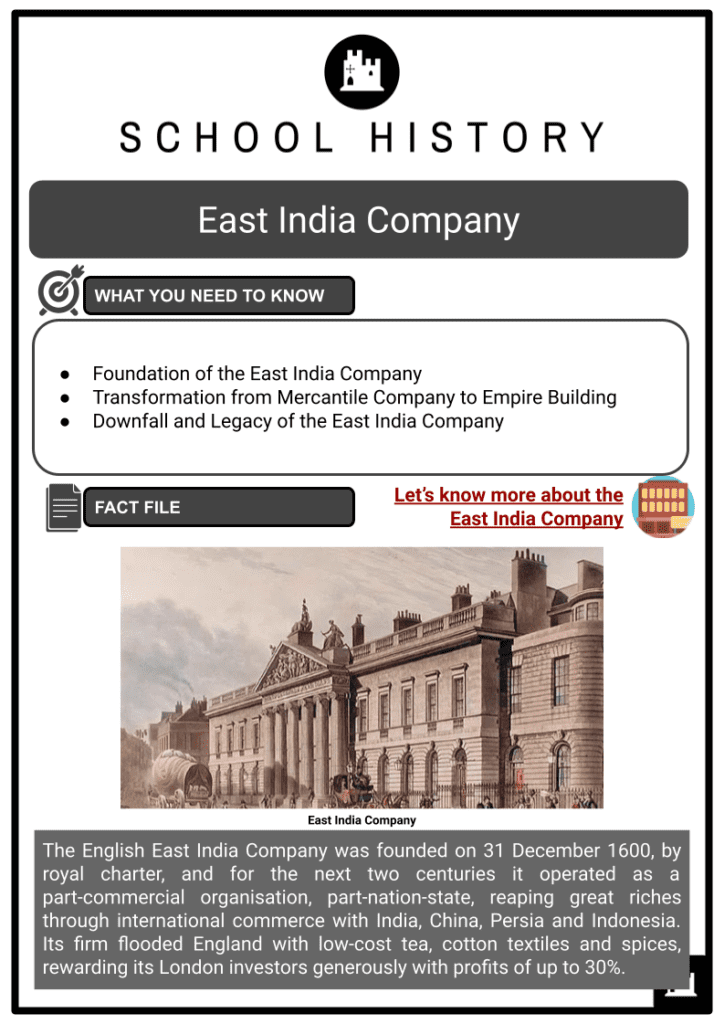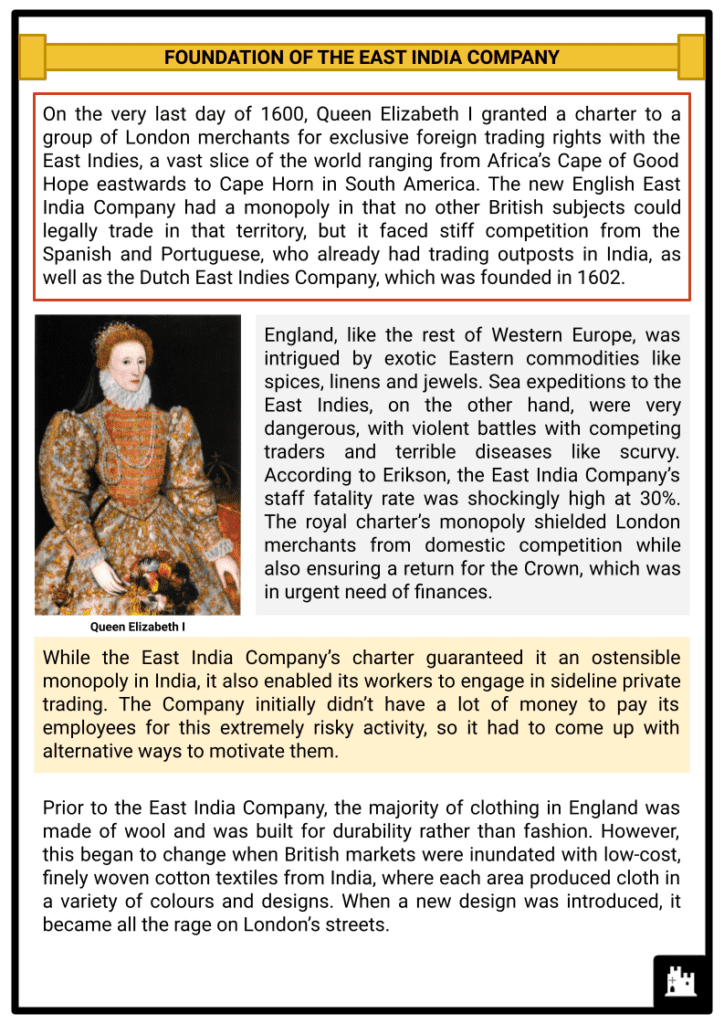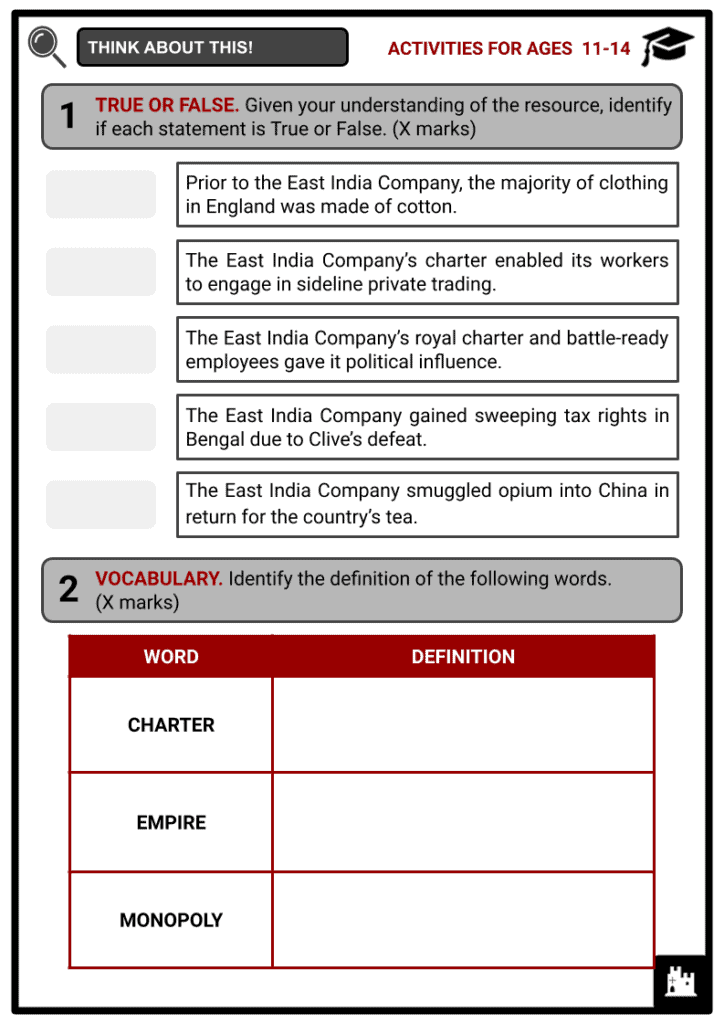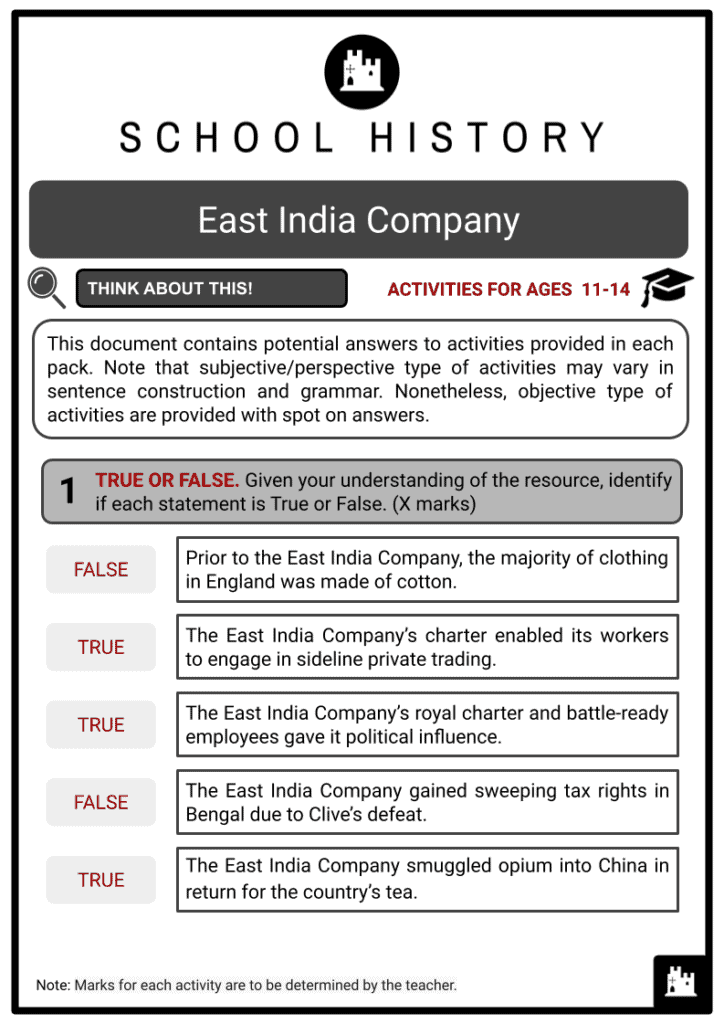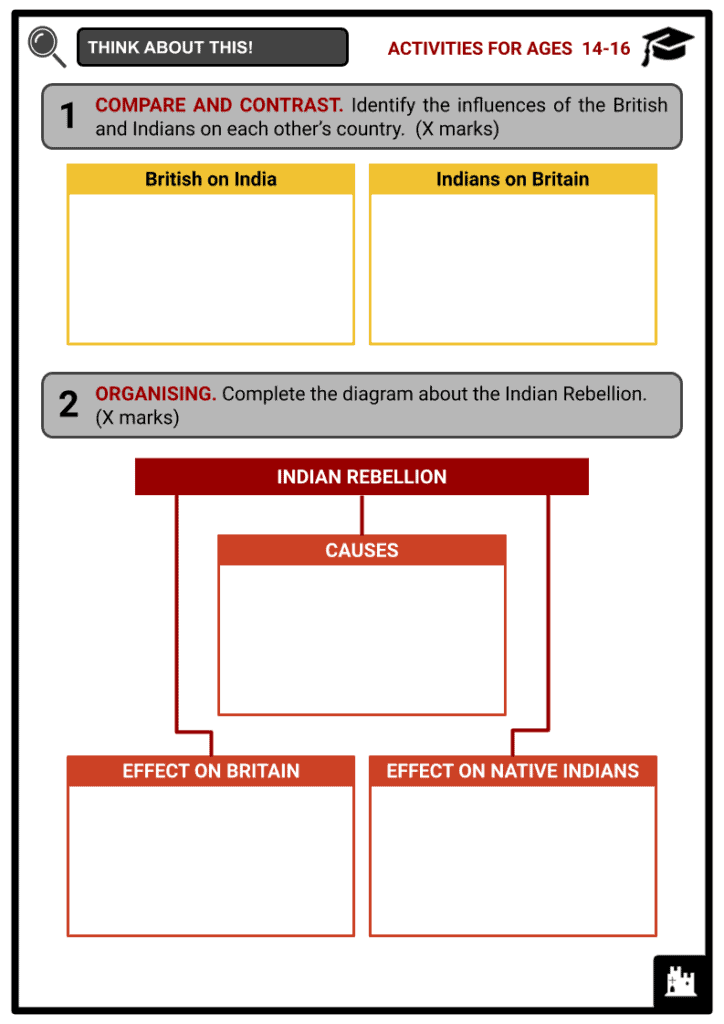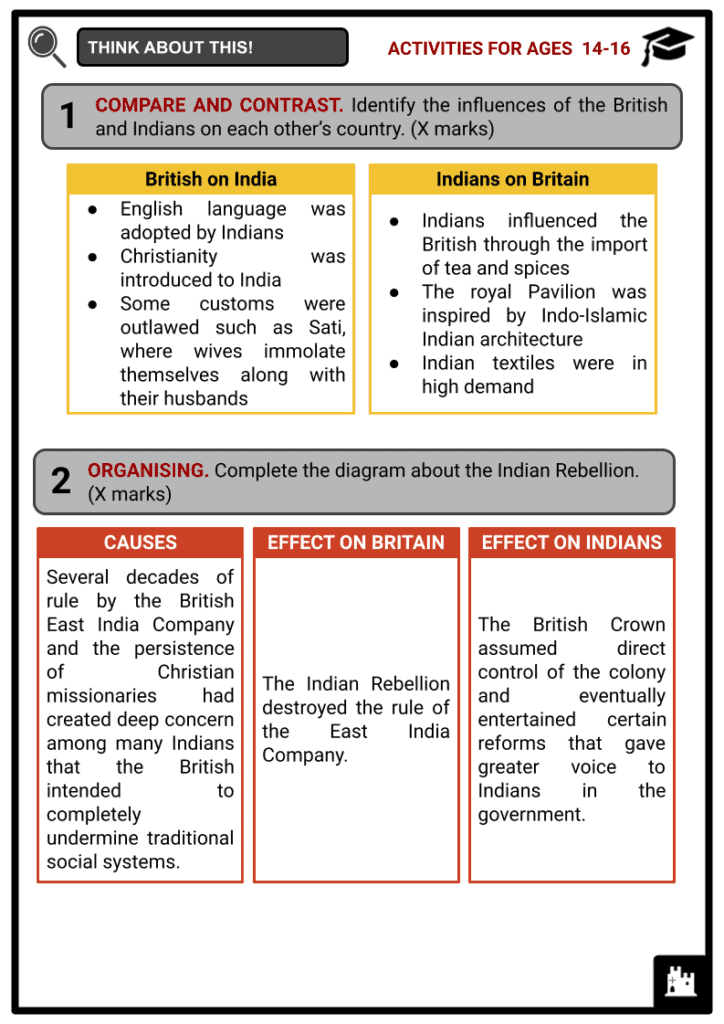Download East India Company Worksheets
Do you want to save dozens of hours in time? Get your evenings and weekends back? Be able to teach about the East India Company to your students?
Our worksheet bundle includes a fact file and printable worksheets and student activities. Perfect for both the classroom and homeschooling!
Summary
- Foundation of the East India Company
- Transformation from Mercantile Company to Empire Building
- Downfall and Legacy of the East India Company
Key Facts And Information
Let’s know more about the East India Company!
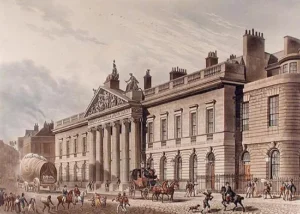
The English East India Company was founded on 31 December 1600, by royal charter, and for the next two centuries, it operated as a part-commercial organisation, part-nation-state, reaping great riches through international commerce with India, China, Persia, and Indonesia. Its firm flooded England with low-cost tea, cotton textiles, and spices, rewarding its London investors generously with profits of up to 30%.
Foundation of the East Indian Company
- On the very last day of 1600, Queen Elizabeth I granted a charter to a group of London merchants for exclusive foreign trading rights with the East Indies, a vast slice of the world ranging from Africa’s Cape of Good Hope eastwards to Cape Horn in South America. The new English East India Company had a monopoly in that no other British subjects could legally trade in that territory, but it faced stiff competition from the Spanish and Portuguese, who already had trading outposts in India, as well as the Dutch East Indies Company, which was founded in 1602.
-
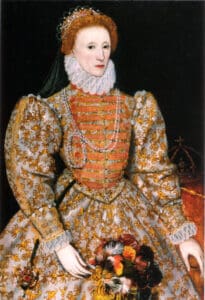
Queen Elizabeth I England, like the rest of Western Europe, was intrigued by exotic Eastern commodities like spices, linens, and jewels. Sea expeditions to the East Indies, on the other hand, were very dangerous, with violent battles with competing traders and terrible diseases like scurvy. According to Erikson, the East India Company’s staff fatality rate was shockingly high at 30%. The royal charter’s monopoly shielded London merchants from domestic competition while also ensuring a return for the Crown, which was in urgent need of finances.
- In 1608, company ships began to dock at Surat. Five years later, the first Indian factory was created in Surat, Gujarat. It was followed by the establishment of the second factory at Masulipatnam in 1616.
- In 1615, Sir Thomas Roe was sent to the Mughal Empire by James I to negotiate a commercial treaty with emperor Jahangir. Roe was successful as the Mughals accepted the company's exclusive rights to establish factories in Surat and other parts of the empire in return for rare European goods.
- By 1647, EIC had 23 factories in India. The treaty was expanded to Bengal in 1634 under emperor Shah Jahan. In 1717, customs duties in Bengal were completely waived.
- One of the first pieces of evidence of EIC participation in the slave trade was recorded in 1684 when Captain Robert Knox purchased and transported 250 slaves from Madagascar.
- Some accounts mentioned that as early as the 1620s, the EIC had begun transporting slaves in the Atlantic.
- While the East India Company’s charter guaranteed it an ostensible monopoly in India, it also enabled its workers to engage in sideline private trading. The Company initially didn’t have a lot of money to pay its employees for this extremely risky activity, so it had to come up with alternative ways to motivate them.
- Prior to the East India Company, the majority of clothing in England was made of wool and was built for durability rather than fashion. However, this began to change when British markets were inundated with low-cost, finely woven cotton textiles from India, where each area produced cloth in a variety of colours and designs. When a new design was introduced, it became all the rage on London’s streets.
- When the British and other European traders arrived in India, they had to gain favour with local monarchs and kings, notably the powerful Mughal Empire, which covered the whole continent. Despite the fact that the East India Company was a private company, its royal charter and battle-ready employees gave it political influence. Local Company leaders were invited to court, bribes were taken, and the Company’s muscle was used in regional conflict, sometimes against French or Dutch commercial businesses.
- The Mughal Empire centered its authority on India’s interior, leaving coastal towns more vulnerable to foreign influence. One of the reasons the East India Company required so much pooled wealth from the beginning was to conquer and fortify commercial outposts in port cities such as Bombay, Madras, and Calcutta. When the Mughal Empire fell apart in the 18th century, fighting erupted in the interior, attracting more Indian traders to these company-run coastal ‘mini kingdoms’.
- Aside from the Mughal Empire, the EIC also negotiated trade agreements with the Tokugawa shogunate. In 1613, Captain John Saris of the Clove was the first British ship to dock in Japan. Saris established a commercial house in Hirado on the Kyushu island.
- However, from 1616 until its closing in 1623, EIC trading was limited to Hirado and Nagasaki.
Transition to merchantile company to Empire building
- After the Battle of Plassey in 1757, a crucial turning point in the East India Enterprise’s transformation from a profitable trading company to a fully fledged empire occurred. Fifty thousand Indian warriors under the command of the Nawab of Bengal fought against just three thousand Company men in this fight. The Nawab was furious at the Company for avoiding paying taxes. However, the Nawab was unaware that the East India Company’s military commander in Bengal, Robert Clive, had made a secret arrangement with Indian financiers to ensure that the majority of the Indian army declined to fight at Plassey.
- With Clive’s triumph, the East India Company gained sweeping taxing rights in Bengal, which was then one of India’s richest provinces. Clive scavenged the Nawab’s wealth and returned it to London. Erikson considers the East India Company’s activities in Bengal to be a watershed moment in the company’s history.
- “This completely changes the Company’s business model from one that had been focused on profitable trade to one that focused on tax collection,” says Erikson. “That’s when it became a really damaging institution, in my opinion.”
- The British Parliament approved Prime Minister William Pitt’s ‘India Act’ in 1784, formaliding the British government’s control over the East India Company’s land holdings in India. "When this act came into being, the Company ceased to be a very significant trade power or a significant governing power in India," Roy says. “The proper British Empire took hold.”
- The East India Company Act 1784, often known as Pitt’s India Act 1784, was approved by the British Parliament to correct the flaws in the Regulating Act 1773.
- It led to the Crown of Great Britain and the British East India Company establishing dual control or joint governance in India, with the Crown having ultimate power.
- For the first time, the East India Company’s political duties were separated from its business activity by this statute.
- The relationship between the firm and the Crown created by this act changed over time until the British East India Company was liquidated by the Government of India Act 1858.
Downfall and legacy of the East India Company
- The East India Company’s accomplishments did not end in India. The Company smuggled opium into China in return for the country’s most treasured trade good: tea, in one of its darkest moments. China only sold tea for silver, which was scarce in England, therefore the Company circumvented China’s opium restriction by using a black market of Indian opium cultivators and smugglers. Millions of Chinese men wasted away in opium dens while tea flowed into London, enriching the Company’s stockholders.
- The Opium War of 1840 began when China cracked down on the opium trade, prompting the British government to dispatch warships. The devastating Chinese loss ceded Hong Kong to the British, but the fight exposed the East India Company’s shady actions for the sake of profit.
-
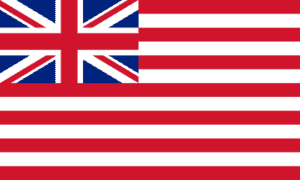
Company Flag By the mid-19th century, parliamentary resistance to the East India Company’s monopoly status had reached fever pitch, fuelled by Adam Smith’s free-market arguments. According to Erikson, the East India Company’s demise in the 1870s was caused less by moral outrage over corporate corruption (of which there was plenty), and more by English politicians and businessmen realising that they could make more money trading with partners who were on a more solid economic footing, rather than captive patrons of a corporate state. In 1873, the East India Stock Dividend Redemption Act formally dissolved the EIC.
- Despite the fact that the East India Company ceased operations more than a century ago, its legacy as a ruthless corporate pioneer has influenced how modern business is conducted in a global market.
- “It’s hard to understand the global political structure without understanding the role of the Company,” says Erikson. “I don’t think we’d have a global capitalist economic system that looks the way it does if England hadn’t become so uniquely powerful at this point in history. They transitioned into a modern industrial force and exported their vision of production and governance to the rest of the world, including North America. It’s the cornerstone of the modern liberal global political order.”

